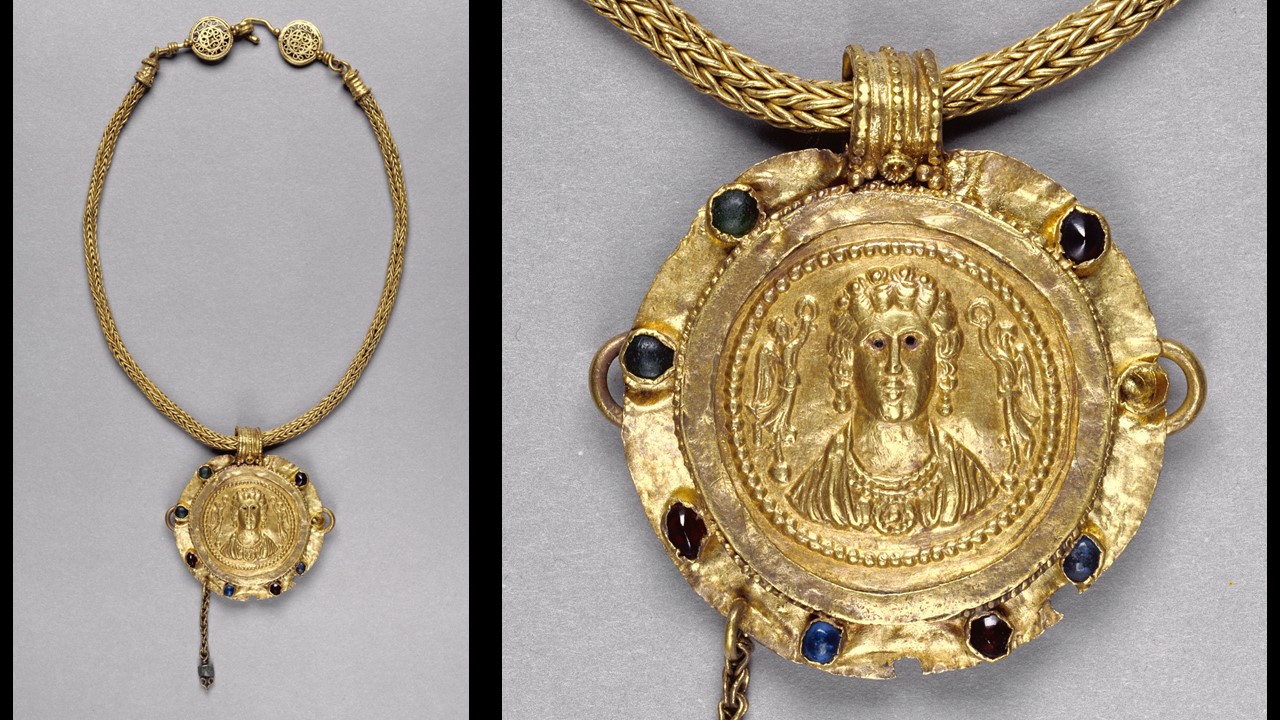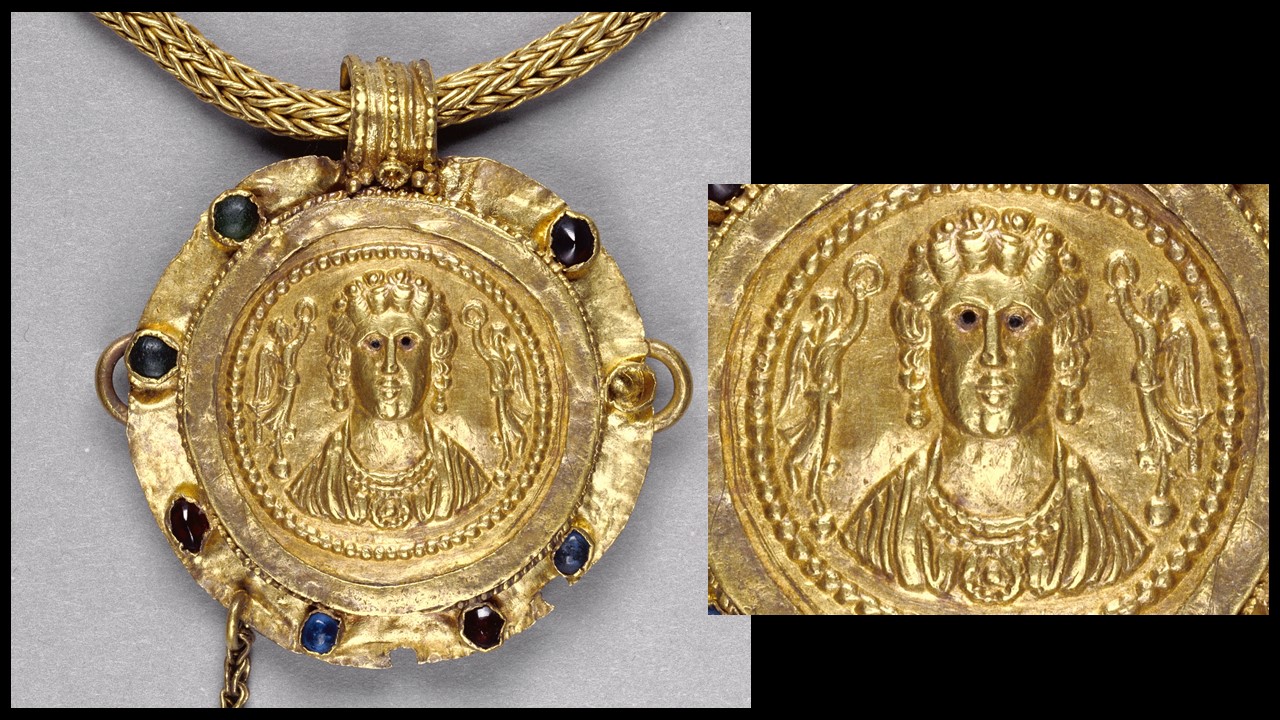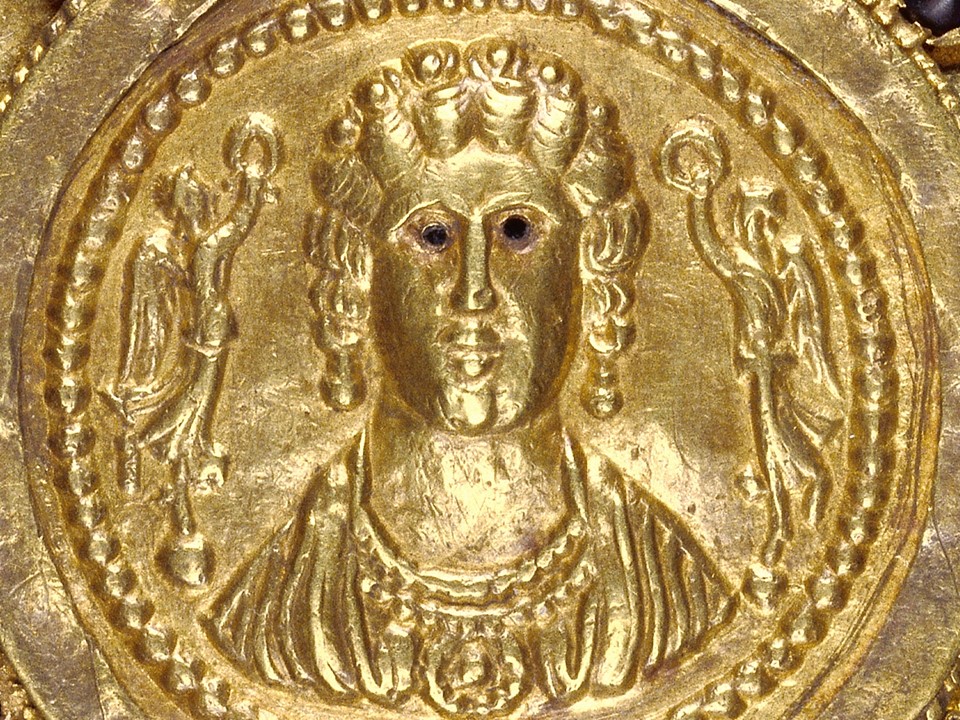
St. Ambrose describes her, Aelia Flacilla, wife of emperor Theodosius I, as “a soul true to God” (Fidelis anima Deo. – “De obitu Theodosii”, n. 40, in P. L., XVI, 1462). In his panegyric, St. Gregory of Nyssa bestowed the highest praise on her virtuous life and pictured her as the helpmate of the emperor in all good works, an ornament of the empire, a leader of justice, an image of beneficence. He praises her as filled with zeal for the Faith, as a pillar of the Church, and as a mother of the indigent. Theodoret in particular exalts her charity and benevolence (Hist. Eccles., V, xix, ed. Valesius, III, 192 sq.). He tells us how she personally tended cripples and quotes a saying of hers: “To distribute money belongs to the imperial dignity, but I offer up for the imperial dignity itself personal service to the Giver.” Could the Pendant with the Bust of an Empress in the Getty Collection depict this extraordinary Early Christian Empress? https://www.ecatholic2000.com/cathopedia/vol6/volsix114.shtml
Let’s answer some questions.
When did the Getty Museum acquire the Pendant with the Bust of an Empress? Yes, we do… Barbara Deppert-Lippitz, a most reputable expert archaeologist in ancient gold, contributed an article, titled A Group o f Late Antique Jewelry in the Getty Museum (pages 107-140) in Studia Varia from the J. Paul Getty Museum: Volume 1 (OPA 8), 1993. Let me quote… The majority of Late Roman and Early Byzantine jewelry that we do have has no known provenance and is undated. Our knowledge of jewelry of the period is based mainly on a few larger hoards with recorded find spots but without any external evidence for dating. It is therefore fortunate that in 1983 the Getty Museum was able to acquire a group of fifteen pieces of jewelry buried around A.D . 400. https://www.getty.edu/publications/virtuallibrary/0892362030.html page 107
Where were the Late Antique pieces of jewelry, including the Pendant with Empress, found? We do not exactly know… but according to Barbara Deppert-Lippitz… As all pieces had a similar patina, it need not be doubted that the group was, indeed, found together. They are all in very good condition, except for missing pearls on some items. Nothing is known about the previous history of this hoard, but no treasure corresponding to the present one is recorded as having been excavated anywhere during this century There are, however, certain indications that the hoard must have come from the eastern part of the Roman Empire. Further interesting observations point out that… The Getty hoard belongs among the well-known treasures from the Hill of Saint Louis in Carthage, Tunisia, and from Ténès in Algeria, both now generally agreed to belong to the period around A.D . 400, and the one from Thetford at Gallows Hill, near Thetfordin Norfolk, dated to the late fourth century A.D. All these hoards are dated on a purely stylistic basis, with no external evidence. https://www.getty.edu/publications/virtuallibrary/0892362030.html page 107, and https://en.wikipedia.org/wiki/Carthage_Treasure and https://www.persee.fr/doc/rbph_0035-0818_1960_num_38_1_2309_t1_0098_0000_2 and https://en.wikipedia.org/wiki/Thetford_Hoard
How did the Getty Museum acquire the Late Antique pieces of Jewelry? In 1983, the J. Paul Getty Museum purchased the group of fifteen pieces of Late Antique pieces of jewelry from the Company of “Robin Symes, Limited,” founded in 1977 and dissolved in 2005. https://www.getty.edu/art/collection/object/103VE6#full-artwork-details

How can you describe the Pendant with the Bust of an Empress? This is actually a necklace consisting of a chain and a circular medallion. The gold ropelike multiple loop-in-loop chain shows remarkable workmanship. It ends with a hook-and-eye clasp, decorated with openwork circlets as well as filigree and granulation. The medallion-shaped pendant displays a frontal female bust flanked by two Victory Goddesses holding wreaths. A circular outer band, with inset garnets, and blue and green glass beads, serving as a frame to the repoussé medallion, was a rather primitive later addition to the original jewel. Three chain pendants and two strong rings attached to either side of the medallion were also added later. Today, only one pendant chain remains attached to the outer frame, holds an emerald, and terminates in a decorative scroll ornament. https://www.getty.edu/publications/virtuallibrary/0892362030.html pages 109-111.

http://colorsandstones.eu/2020/11/08/necklace-with-a-pendant-roman-overview/
Who is the depicted woman? It most probably is Aelia Flacilla, the first wife of Emperor Theodosius I. According to Barbara Deppert-Lippitz… a small but significant detail, the diadem, the Empress wears, offers valuable information. Based on numismatic evidence, similar diadems have been worn only by the empresses Aelia Flacilla, wife of Theodosius I, whose coinage commenced in A.D . 383 and who died in 386, and by her daughter-in-law Eudoxia, wife of Arcadius (A.D . 383-408). This narrows the chronological range of the medallion pendant to the last two decades of the fourth century A.D. The differences between the coin portraits of Flacilla and of Eudoxia are marginal. However, the oval face with a short straight nose, small mouth with thick lips, and energetic chin seem to be closer to the portrait on certain issues of Flacilla than to that of Eudoxia. https://www.getty.edu/publications/virtuallibrary/0892362030.html page 110
For a Student Activity, please… Check HERE!